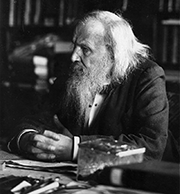E-Archive
Off the Beaten Track
in Vol. 17 - May Issue - Year 2016
A Strange Game of Solitaire


Mendeleev in an 1897 photograph
Most of the passengers had been lulled to sleep by the gentle swaying of the carriages as the train lumbered across the vast plain on a cold winter day in 1869. The surrounding fields were covered with snow and the wood-burning stoves placed in each carriage fought valiantly to defend the travellers against the freezing temperatures outside.
Those few who were not dozing were curiously eyeing one of their fellow passengers occupying a window seat at the far end of the carriage. He was a rather intimidating figure, with a long unkept beard and a mane of shaggy hair that reached his shoulders. A thick woolen scarf wrapped loosely around his neck disappeared into a heavy coat that ended just below his knees. The man was continuously shuffling what appeared to be playing cards, which he would then place one by one on the small folding table in front of his seat. After staring at the arrangement for a few seconds, he would inevitably give a dissatisfied grunt, scoop up all the cards and reshuffle them. This strange game of solitaire continued for the entire journey.
********
The nature of elements and the relationship among them has been the subject of debate since classical times. In the fifth century BC, the Greek philosopher Empedocles surmised that all matter was composed of combinations of what he called roots: fire, air, water and earth. Several years later, these four roots were renamed elements by Plato. But what exactly were these elements?
Quite astonishingly, the fourth-century BC Greek philosopher Aristotle had come up with a definition that was remarkably close to one that was elaborated two thousand years later. He stated that "an element is one of those bodies into which other bodies can decompose, and that itself is not capable of being divided into another." In fact, in 1661 the British scientist Robert Boyle defined an element as "a substance that cannot be broken down into a simpler substance by a chemical reaction." (Boyle's definition remained in use until 1914, when the English physicist Henry Moseley invented a more accurate definition based on the relationship between the X-ray wavelength of an element and its atomic number.)
In 1789 the French chemist Lavoisier proposed a system for naming new elements in his Elementary Treatise on Chemistry, which also included a list of thirty-three elements. His work encouraged other scientists to systematize the elements. Various attempts were made to create a working organizational structure that would allow a better understanding of the characteristics of elements and of how they interacted with one another.
In 1803 the English chemist John Dalton hypothesized that all elements contained variable numbers of hydrogen atoms. On the basis of this theory, he created a scale of atomic weights based on the weight of the hydrogen atom, which was considered to be 1.
In 1863 the French geologist Alexandre-Emile Béguyer de Chancourtois pointed out that similar elements occurred at regular intervals when they are ordered by their atomic weights: he had discovered the periodicity of elements.
During the greater part of the mid-1800s, scientists such as Döbereiner, Newlands, Meyer, Odling and others made major contributions towards the understanding and the classification of the elements, but the breakthrough came thanks to the Russian chemist Dmitri Mendeleev.
Mendeleev wondered if certain physical and chemical characteristics of the elements repeated themselves on a periodic basis. In order to verify this idea, he wrote a card for each of the sixty-three known elements. On each card he indicated the element's symbol, its atomic weight and its most characteristic physical and chemical properties. He would then spend hours and hours arranging and rearranging the cards, often during long train journeys. Mendeleev finally hit upon the right sequence in early 1869. By placing the cards in rows and columns on a table in order of ascending atomic weight and in groups of elements with similar properties, Mendeleev noticed that similar chemical characteristics recurred every seven elements among elements with low atomic weights, whereas certain other characteristics repeated themselves every seventeen elements among heavier elements. Thus the periodic table of elements was born.
Mendeleev published his findings and his table in 1869 in his work entitled On the Relationship of the Properties of the Elements to their Atomic Weights. The genius of his table was that it provided gaps for atomic weights of elements that had not yet been discovered. This allowed Mendeleev to correctly predict the existence of ten new elements, of which seven were eventually discovered.
By Giovanni Gregorat, Contributing Editor MFN
Author: Giovanni Gregorat



























